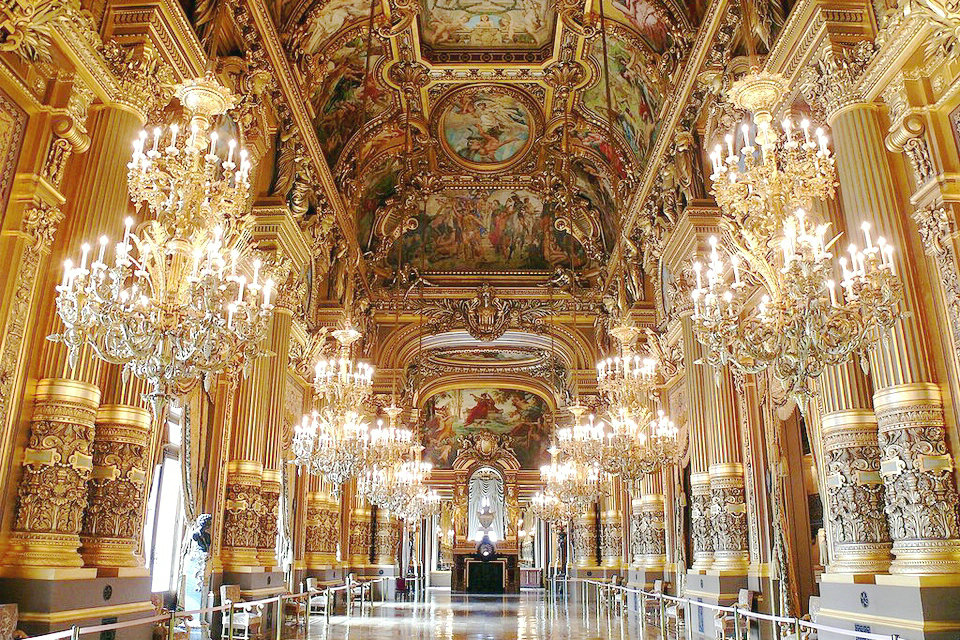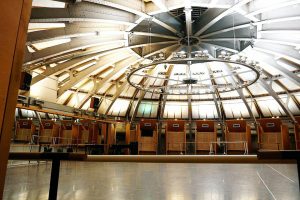The Grand foyer hall, 18 metres (59 ft) high, 154 metres (505 ft) long and 13 metres (43 ft) wide, was designed to act as a drawing room for Paris society. It was restored in 2004. Its ceiling was painted by Paul-Jacques-Aimé Baudry and represents various moments in the history of music. The foyer opens onto an outside loggia and is flanked by two octagonal salons with ceilings painted by Jules-Élie Delaunay in the eastern salon and Félix-Joseph Barrias in the western salon. The octagonal salons open to the north into the Salon de la Lune at the western end of the Avant-Foyer and the Salon du Soleil at its eastern end.
The vault of the forefront 5 is covered with mosaics on gold background with shimmering colors. The view of the nave of the grand staircase is spectacular. In the big focus,the play of mirrors and windows accentuates its vast dimensions. The ceiling painted by Paul Baudry (1828-1886) declines themes of the history of music. The lyre is the main element: it reigns over all the decorative vocabulary, on the capitals as on the heating grilles or the door handles. A copy of the bust of Charles Garnier by the sculptor Carpeaux (1827-1875) is in the center of the foyer, near one of the windows where the perspective of the Avenue de l’Opera opens up to the Louvre, to contemplate more largely from the loggia. The salons of the sun and the moon offer a symbolic and poetic transition to other spaces.
Grand foyer and lounges
The design of the large fireplace reflects the provisions and decorative inspiration galleries castles of the French Renaissance of the xvi th century (Fontainebleau) and the xvii th century (Apollo Gallery at the Louvre, Hall of Mirrors at Versailles). A clever game of mirrors and windows opening on the streets and facadesSurroundings further accentuates its vast dimensions. This place is thought, originally, as a meeting point for spectators of all social categories.
Comprising five bays, the large fireplace is embellished on both sides of a living room. On the side of the foyer, three large openings give access to the traffic that leads to the galleries of the grand staircase and the room. A large bay gives access from each small octagonal lounge to a rotunda: the “Moon Lounge”, located on the garden side, and the “Sun Lounge”, courtyard side. On either side of the axial door, large mirrors, about six meters high, rise from the floor and paneling. On the other side, five large French windows are the pendants and indicate access to the loggia.
On the walls are twenty elegant statues, allegories of “Qualities” essential to artists of the lyrical and choreographic arts.
A ceiling coving, painted by Paul Baudry, face the great stages of the history of music, the Comedy and Tragedy and accepts many aspects of their own theme.
The lyre -shaped, as in very many places outside and inside of the building including the auditorium, a decorative element of choice punctuating, almost systematically, various moldings, capitals, gates of heating – and even – handles door.
Until the xix th century and as tradition dictates, the show places of homes are reserved for the exclusive use of the representatives of the male. The ladies receive during this time in their respective box. But on the day of the inauguration of the Garnier Palace, the Queen of Spain wishes to admire the gallery of the grand foyer. The taboo broken, it is immediately followed by his immediate entourage, then other ladies of the good society of the time who do not wish to remain behind.
Unbeknownst to Charles Garnier, his collaborators ask several workers to carve two golden busts of Apollo in his image. Both works are at the height of the ceiling. Another copy of the bust of the architect, sculpted by Carpeaux, sits in the center of the large foyer and near a window overlooking the perspective of the Avenue de l’Opera.
In 1928, an unfortunate fire deprived the grand foyer of its gold curtains and hangings; these are not restored until a complete restoration of the gallery, completed in 2004.
Moon and Sun Shows
Placed at the east and west ends of the hearth, two small rotundas are painted by decorators Philippe Marie Chaperon and Auguste Alfred Rubé, friends of Garnier.
On the vaults of the “Salon de la Lune ” and the “Salon du Soleil “, dominate, in one, the cold tones of silver, with representations of night birds: owls and bats and, in the other, the warm tones of gold, in the middle of a salamander setting. Of mirrors tin, the first color of cold and hot second dominant, respectively overlie their walls and are reflected to infinity to form ” light paths “.
Palais Garnier
The Opera Garnier, or Palace Garnier, is a national theater and lyrical choreography vocation and a major element of heritage 9 th arrondissement of Paris and the capital. It is located Place de l’Opera, at the north end of the Avenue de l’Opera and at the crossroads of many roads. It is accessible by metro (Opera station), by the RER (line A, Auber station) and by bus. The building stands out as a monument particularly representative of eclectic architectureand historicist style of the second half of the xix th century. On a conception of the architect Charles Garnier retained following a competition, its construction, decided by Napoleon III as part of the transformations of Paris conducted by the prefect Haussmann and interrupted by the war of 1870, was resumed at the beginning of the Third Republic, after the destruction by fire of the opera Le Peletier in 1873. The building is inaugurated on January 5, 1875by President MacMahon in the third Republic.
Designed by the architect Charles Garnier in 1875, the Palais Garnier houses a prestigious auditorium and public spaces (grand foyer, rotunda of subscribers, salons), a library-museum as well as several rehearsal studios and workshops.
The “Italian style” theater, whose ceiling was painted by Marc Chagall in 1964, can accommodate 2054 spectators. With nearly 480,000 visitors a year, it is one of the most visited monuments in Paris. It is classified as a historical monument since 1923.
This opera was called “Paris Opera” until 1989, when the opening of the Opera Bastille, also opera in Paris, influenced its name. It is now designated by the only name of its architect: “Opera Garnier” or “Palais Garnier”. The two operas are now grouped together in the public industrial and commercial establishment “Opéra national de Paris”, a French public institution whose mission is to implement the performance of lyric or ballet performances, of high quality. artistic. The opera Garnier has been classified as a historical monument since October 16, 1923.











